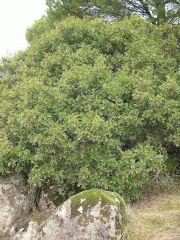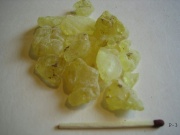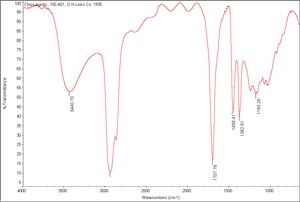Mastic resin
Description
A pale, yellow natural resin produced by the evergreen mastic shrub, Pistacia lentiscus, which occurs in southern Europe and northern Africa. Mastic is a triterpenoid resin; some of its identified components are euphane, oleanic acid and a bicyclic diol (Mills and White 1994). Mastic is sold commercially in small, transparent 'tears' of a pale straw color. The resin collected from the Greek island of Chios has a reputation for the highest quality. Mastic was used in 16th and 17th century recipes for oil/resin varnishes and later in with mixtures of other resin. In the 19th century, mastic was a popular clear, glossy spirit varnish for oil paintings and was also used as an additive in oil medium called megilp. By the 20th century, its use was superseded by dammar. Mastic varnish is prepared by placing the resin bits in a gauze bag suspended in solvent. Mastic varnishes yellow and become insoluble with age. Mastic is also used as a chewing gum and a flavoring agent in an alcoholic beverage called mastica.
Synonyms and Related Terms
Pistacia lentiscus; Mastix (Deut.); resina almáciga (Esp.); lentisque (Fr.); pistachier lentisque (Fr.); resina mastice (It); mastiekboom (Ned.); mastix (Sven., Slov.); mastich; mastica; gum mastic; Chios mastic; Indian mastic; Bombay mastic; khinjak; Turkish mastic; pistacia galls; lentisk
Other Properties
Soluble in oil, turpentine, ethanol, diethyl ether, benzene, acetone, chloroform. Insoluble in water and ligroin. Saponification number = 82-92. Acid number = 50-71.
| Melting Point | 95-120 |
|---|---|
| Density | 1.074 |
| Molecular Weight | Tg =34.7 C |
| Refractive Index | 1.535-1.536 |
Hazards and Safety
Darkens with age. May turn cloudy if moisture is present during preparation.
Additional Information
° E.Mention, "Natural Resin Varnishes: Mastic" AIC Painting Conservation Catalog, Varnishes and Surface Coatings, p.55, 1998. ° J.S. Mills, R.White, The Organic Chemistry of Museum Objects, Butterworth Heinemann, London, 1994.
Comparisons
Additional Images
Sources Checked for Data in Record
- Encyclopedia Britannica, http://www.britannica.com Comment: "Mastic." Encyclopædia Britannica. 2004. Encyclopædia Britannica Premium Service. 14 Apr. 2004 .
- Wikipedia, the free encyclopedia, at http://www.wikipedia.com Comment: http://en.wikipedia.org/wiki/Mastic (Accessed Feb. 10, 2006)
- R. J. Gettens, G.L. Stout, Painting Materials, A Short Encyclopaedia, Dover Publications, New York, 1966 Comment: melting point = 95C; specific gravity = 1.074
- G.S.Brady, Materials Handbook, McGraw-Hill Book Co., New York, 1971 Comment: p. 500
- Ralph Mayer, A Dictionary of Art Terms and Techniques, Harper and Row Publishers, New York, 1969 (also 1945 printing)
- Hermann Kuhn, Conservation and Restoration of Works of Art and Antiquities, Butterworths, London, 1986 Comment: meltin point=105-120 C
- Matt Roberts, Don Etherington, Bookbinding and the Conservation of Books: a Dictionary of Descriptive Terminology, U.S. Government Printing Office, Washington DC, 1982
- John S. Mills, Raymond White, The Organic Chemistry of Museum Objects, Butterworth Heineman, London, 2nd ed., 1994
- Thomas B. Brill, Light Its Interaction with Art and Antiquities, Plenum Press, New York City, 1980 Comment: ref. index = 1.536
- Susan E. Schur, Conservation Terminology: A review of Past & Current Nomenclature of Materials, Technology and Conservation, Spring (p.34-39); Summer (p.35-38); Fall (p.25-36), 1985
- Paintings Specialty Group, Painting Conservation Catalog, Wendy Samet (ed.), AIC, Washington, DC, 1998
- The American Heritage Dictionary or Encarta, via Microsoft Bookshelf 98, Microsoft Corp., 1998
- Art and Architecture Thesaurus Online, http://www.getty.edu/research/tools/vocabulary/aat/, J. Paul Getty Trust, Los Angeles, 2000
- CRC Handbook of Chemistry and Physics, Robert Weast (ed.), CRC Press, Boca Raton, Florida, v. 61, 1980 Comment: Brill - ref. index = 1.535







